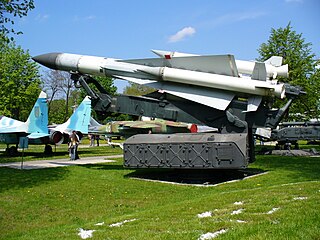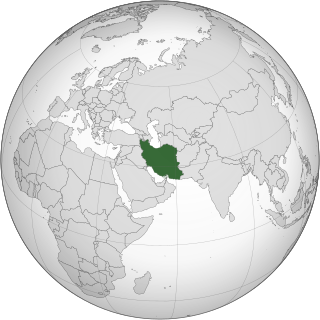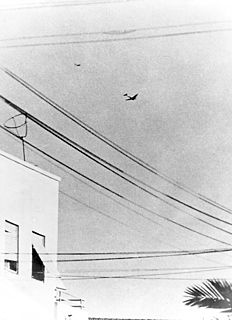Related Research Articles

The Israeli Air Force operates as the aerial warfare branch of the Israel Defense Forces. It was founded on May 28, 1948, shortly after the Israeli Declaration of Independence. As of April 2022, Aluf Tomer Bar has been serving as the Air Force commander.

The Arrow or Hetz is a family of anti-ballistic missiles designed to fulfill an Israeli requirement for a missile defense system that would be more effective against ballistic missiles than the MIM-104 Patriot surface-to-air missile. Jointly funded and produced by Israel and the United States, development of the system began in 1986 and has continued since, drawing some contested criticism. Undertaken by the MALAM division of the Israel Aerospace Industries (IAI) and Boeing, it is overseen by the Israeli Ministry of Defense's "Homa" administration and the U.S. Missile Defense Agency. It forms the long-range layer of Israel's multi-tiered missile defence system, along with David's Sling and both Iron Dome and Iron Beam.

The Shahab-3 is a liquid-propelled medium-range ballistic missile (MRBM) developed by Iran and based on the North Korean Nodong-1. The Shahab-3 has a range of 1,000 kilometres (620 mi); a MRBM variant can now reach 2,000 kilometres (1,200 mi). It was tested from 1998 to 2003 and added to the military arsenal on 7 July 2003, with an official unveiling by Ayatollah Khamenei on July 20. With an accuracy of 140 m CEP, the Shahab-3 missile is primarily effective against large, soft targets. Given the Shahab-3’s payload capacity, it would likely be capable of delivering nuclear warheads. According to the IAEA, Iran in the early 2000s may have explored various fuzing, arming and firing systems to make the Shahab-3 more capable of reliably delivering a nuclear warhead.

The NPO Almaz S 200 Angara/Vega/Dubna, NATO reporting name SA-5 Gammon, is a long range, high altitude surface-to-air missile (SAM) system designed in the 1960s to defend large areas from high-altitude bombers or other targets. Each battalion has 6 single-rail missile launchers for the 10,800 mm (35.4 ft) long missiles and a fire control radar. It can be linked to other, longer-range radar systems.

Iran–Israel relations can be divided into four major phases: the ambivalent period from 1947 to 1953, the friendly period during the era of the Pahlavi dynasty from 1953 to 1979, the worsening period following the Iranian Revolution from 1979 to 1990, and the ongoing period of open hostility since the end of the Gulf War in 1991. In 1947, Iran was among 13 countries that voted against the United Nations Partition Plan for the British Mandate of Palestine. Two years later, Iran also voted against Israel's admission to the United Nations.

The Navy of the Islamic Revolutionary Guard Corps is the naval warfare service of the Islamic Revolutionary Guard Corps founded in 1985, and one of the two maritime forces of Iran, parallel to the conventional Islamic Republic of Iran Navy. The IRGC has been designated as a terrorist organization by the governments of Bahrain, Saudi Arabia and the United States. IRGC's Navy has steadily improved its capabilities to support unconventional warfare and defend Iran's offshore facilities, coastlines, and islands in the Persian Gulf.
According to 2012 polls, a majority of Americans supported United States or Israeli military action against Iran. More recent polls report that Americans "back a newly brokered nuclear deal with Iran by a 2-to-1 margin and are very wary of the United States resorting to military action against Tehran even if the historic diplomatic effort falls". Organised opposition to a possible future military attack against Iran by the United States (US) and/or Israel is known to have started during 2005–2006. Beginning in early 2005, journalists, activists and academics such as Seymour Hersh, Scott Ritter, Joseph Cirincione and Jorge E. Hirsch began publishing claims that United States' concerns over the allege threat posed by the possibility that Iran may have a nuclear weapons program might lead the US government to take military action against that country. These reports, and the concurrent escalation of tensions between Iran and some Western governments, prompted the formation of grassroots organisations, including Campaign Against Sanctions and Military Intervention in Iran in the US and the United Kingdom, to advocate against potential military strikes on Iran. Additionally, several individuals, grassroots organisations and international governmental organisations, including the Director-General of the International Atomic Energy Agency, Mohamed ElBaradei, a former United Nations weapons inspector in Iraq, Scott Ritter, Nobel Prize winners including Shirin Ebadi, Mairead Corrigan-Maguire and Betty Williams, Harold Pinter and Jody Williams, Campaign for Nuclear Disarmament, Code Pink, the Non-Aligned Movement of 118 states, and the Arab League, have publicly stated their opposition to such an attack.

United Nations Security Council Resolution 1747 was a United Nations Security Council resolution, written with reference to some IAEA reports, that tightened the sanctions imposed on Iran in connection with the Iranian nuclear program. It was adopted unanimously by the United Nations Security Council on 24 March 2007.

Military relations between Israel and the United States have been consistently close, reflecting shared security interests in the Middle East. Israel is designated as a major non-NATO ally by the U.S. government. A major purchaser and user of U.S. military equipment, Israel is also involved in the joint development of military technology and regularly engages in joint military exercises involving United States and other forces. The relationship has deepened gradually over time, though, as Alan Dowty puts it, it was "not a simple linear process of growing cooperation, but rather a series of tendentious bargaining situations with different strategic and political components in each."

The Islamic Republic of Iran Armed Forces are the combined military forces of Iran, comprising the Islamic Republic of Iran Army (Arteš), the Islamic Revolutionary Guard Corps (Sepâh) and the Law Enforcement Force (Police).

Iron Dome is a mobile all-weather air defense system developed by Rafael Advanced Defense Systems and Israel Aerospace Industries. The system is designed to intercept and destroy short-range rockets and artillery shells fired from distances of 4 kilometres (2.5 mi) to 70 kilometres (43 mi) away and whose trajectory would take them to an Israeli populated area. From 2011 to 2021, the United States contributed a total of US$1.6 billion to the Iron Dome defense system, with another US$1 billion approved by the US Congress in 2022.

The Harpoon is an all-weather, over-the-horizon, anti-ship missile developed and manufactured by McDonnell Douglas. The AGM-84E Standoff Land Attack Missile (SLAM) and later AGM-84H/K SLAM-ER are cruise missile variants.

The History of the Israel Air Force begins in May 1948, shortly after the formation of the State of Israel. Following Israel's declaration of independence on May 14, its pre-state national institutions transformed into the agencies of a state, and on May 26, 1948, the Israeli Air Force was formed. Beginning with a small collection of light aircraft, the force soon transformed into a comprehensive fighting force. It has since participated in several wars and numerous engagements, becoming what has been described as "The mightiest air force in the Middle East".

The 2012 US-Israel military defense drill, codenamed Austere Challenge 12, was a military exercise between the United States, Israeli military, Germany and United Kingdom, that took place in late October 2012.

The Iran–Israel proxy conflict, also known as the Iran–Israel proxy war or Iran–Israel Cold War, is an ongoing proxy war between Iran and Israel. The conflict involves threats and hostility by Iran's leaders against Israel, and their declared objective to dissolve the Jewish state. Iran has provided funding, weapons, and training to groups including Lebanese Hezbollah, and Palestinian Islamic Jihad (PIJ), which have vowed and carried out attacks on Israel, and which have been designated terrorist organisations by many countries. Because of Iran's hostility to Israel, Israel is also concerned by Iran's nuclear weapons program and missile program, and is seeking to downgrade Iran's allies and proxies, as well as preventing Iranian entrenchment in Syria, another sworn enemy of Israel.
Cyberwarfare is a part of Iran's "soft war" military strategy. Being both a victim and wager of cyberwarfare, Iran is considered an emerging military power in the field.
On 10 February 2018, an Israeli F-16I was shot down by the Syrian air defenses after conducting an air raid on Iran-backed positions inside Syrian territory. The aircraft was part of a larger Israeli aerial dispatch which Israel said was sent in response to detection of an Iranian drone spying on Israel. Two hours after the downing of the jet, Israel began attacking additional targets inside Syria, including air defense sites and Iranian targets near Damascus. Israel stated it destroyed the Syrian military's main command and control bunker. Iran dismissed the Israeli allegation of Iranian drone incursion into Israeli territory as "ridiculous".
The May 2018 Israel–Iran clashes were a series of short military confrontations between Israeli and Iranian forces in Syria. On 10 May 2018 the Israeli military stated that Iranian forces in Syria launched 20 rockets against Israeli army positions on Western Golan Heights. The Syrian Observatory for Human Rights said that the attack occurred after Baath, a town in the demilitarised zone, was bombarded by Israeli forces. According to the Israel Defense Forces (IDF) some missiles were intercepted by Israel's Iron Dome system, while some fell short in Syrian territory.
The Iran–Israel conflict during the Syrian civil war refers to the Iranian-Israeli standoff in and around Syria during the course of the Syrian conflict. With increasing Iranian involvement in Syria from 2011 onwards, the conflict shifted from a proxy war into a direct confrontation by early 2018.
References
- 1 2 "U.S., Israel Team Up for Biannual "Juniper Cobra" Military Exercise". The Tower Magazine. 18 May 2014. Retrieved 25 August 2014.
- ↑ Vasudevan Sridharan (18 May 2014). "US and Israel Hold Anti-Missile Defence Drill Juniper Cobra". International Business Times. Retrieved 25 August 2014.
- ↑ Opall-Rome, Barbara (2018-03-08). "US, Israel in 'dress rehearsal' for joint response against Iran missile attack". Defense News. Retrieved 2018-03-11.